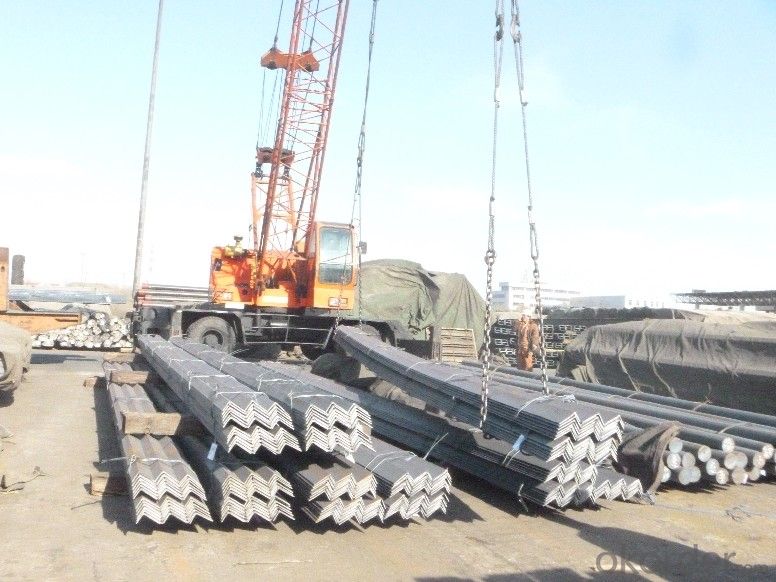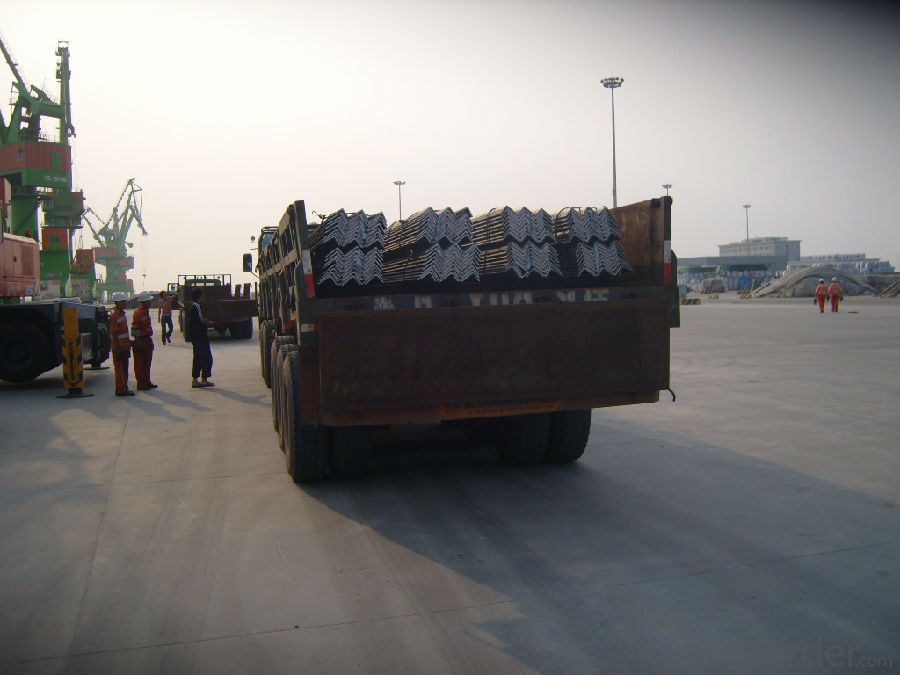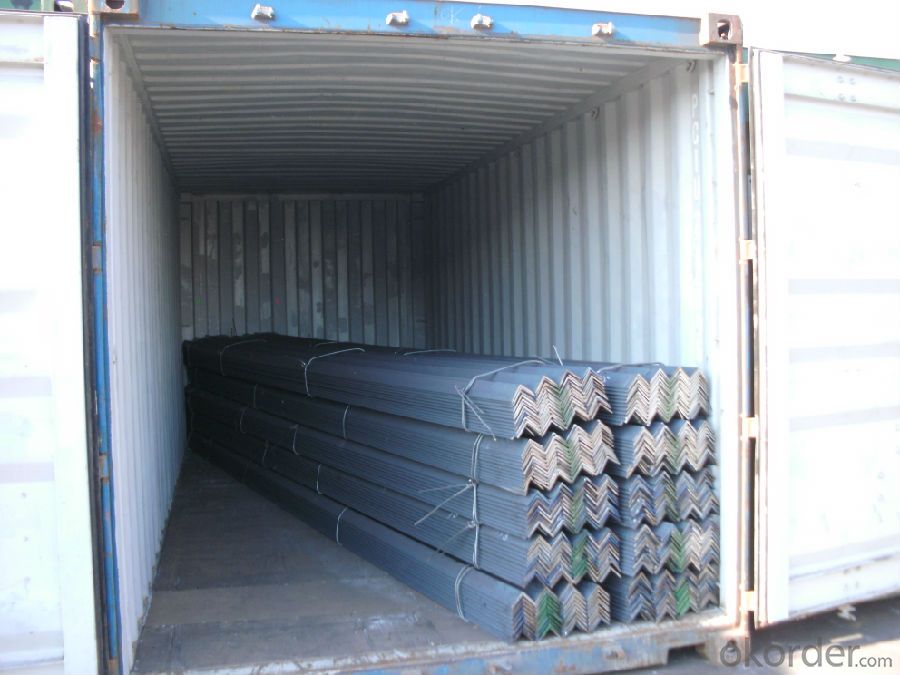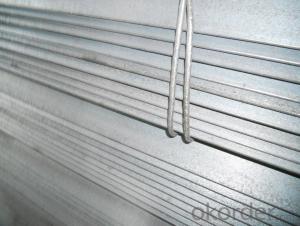Mild Steel Prime Hot Rolled Angle Bar Steel
- Loading Port:
- China main port
- Payment Terms:
- TT OR LC
- Min Order Qty:
- 100 m.t.
- Supply Capability:
- 10000 m.t./month
OKorder Service Pledge
OKorder Financial Service
You Might Also Like
Item specifice
Product Description:
OKorder is offering Mild Steel Prime Hot Rolled Angle Steel at great prices with worldwide shipping. Our supplier is a world-class manufacturer of steel, with our products utilized the world over. OKorder annually supplies products to African, South American and Asian markets. We provide quotations within 24 hours of receiving an inquiry and guarantee competitive prices.
Product Applications:
Mild Steel Prime Hot Rolled Angle Steel are ideal for structural applications and are widely used in the construction of buildings and bridges, and the manufacturing, petrochemical, and transportation industries.
Product Advantages:
OKorder's Mild Steel Prime Hot Rolled Angle Steel are durable, strong, and wide variety of sizes.
Main Product Features:
· Premium quality
· Prompt delivery & seaworthy packing (30 days after receiving deposit)
· Can be recycled and reused
· Mill test certification
· Professional Service
· Competitive pricing
Product Specifications:
Manufacture: Hot rolled
Grade: Q195 – 235
Certificates: ISO, SGS, BV, CIQ
Length: 6m – 12m, as per customer request
Packaging: Export packing, nude packing, bundled
EQUAL ANGLES SIZES | |||
a(mm) | a1(mm) | thickness(mm) | length |
25 | 25 | 2.5---3.0 | 6M/12M |
30 | 30 | 2.5---4.0 | 6M/12M |
38 | 38 | 2.5 | 6M/12M |
38 | 38 | 3.0---5.0 | 6M/12M |
40 | 40 | 3.0---6.0 | 6M/12M |
50 | 50 | 3 | 6M/12M |
50 | 50 | 3.7---6.0 | 6M/9M/12M |
60 | 60 | 5.0---6.0 | 6M/9M/12M |
63 | 63 | 6.0---8.0 | 6M/9M/12M |
65 | 65 | 5.0---8.0 | 6M/9M/12M |
70 | 70 | 6.0---7.0 | 6M/9M/12M |
75 | 75 | 5.0---10.0 | 6M/9M/12M |
80 | 80 | 6.0---10.0 | 6M/9M/12M |
90 | 90 | 6.0---10.0 | 6M/9M/12M |
100 | 100 | 6.0---12.0 | 6M/9M/12M |
120 | 120 | 8.0-12.0 | 6M/9M/12M |
125 | 125 | 8.0---12.0 | 6M/9M/12M |
130 | 130 | 9.0-12.0 | 6M/9M/12M |
140 | 140 | 10.0-16.0 | 6M/9M/12M |
150 | 150 | 10---15 | 6M/9M/12M |
160 | 160 | 10---16 | 6M/9M/12M |
180 | 180 | 12---18 | 6M/9M/12M |
200 | 200 | 14---20 | 6M/9M/12M |
FAQ:
Q1: Why buy Materials & Equipment from OKorder.com?
A1: All products offered byOKorder.com are carefully selected from China's most reliable manufacturing enterprises. Through its ISO certifications, OKorder.com adheres to the highest standards and a commitment to supply chain safety and customer satisfaction.
Q2: How do we guarantee the quality of our products?
A2: We have established an advanced quality management system which conducts strict quality tests at every step, from raw materials to the final product. At the same time, we provide extensive follow-up service assurances as required.
Q3: How many tons of steel products could be loaded in containers?
A3: Usually the steel products are delivered by bulk vessel because of the large quantity and the freight. However, there are no bulk vessel enter some seaports so that we have to deliver the cargo by containers. The 6m steel product can be loaded in 20FT container, but the quantity is changed according to the size, usually from 18tons to 25tons.
Q4: what is the difference between actual weight and theoretical weight?
A4: All the section steel has two weights: actual weight and theoretical weight. Actual weight is the weighing out when the product delivered from the mill. Theoretical weight is calculated by pieces. The invoice can be based on each of them as your request.
Images:



- Q:How are steel angles measured?
- Steel angles are measured using two main dimensions: the length of each leg and the thickness of the material. The length of each leg refers to the distance from the intersection point of the two legs to the end of each leg. This measurement is usually expressed in inches or millimeters. The thickness of the material, also known as the gauge, is the measurement of the width of the steel angle. It is typically expressed in fractions of an inch or in millimeters. To provide a comprehensive measurement, steel angles are often described using a combination of these two dimensions. For example, a common specification could be "2 x 2 x 1/4," indicating that the steel angle has legs measuring 2 inches in length, a thickness of 1/4 inch, and both legs are equal in length. It is important to note that steel angles can be measured differently depending on the specific industry or region. Some industries may use metric measurements, while others may use imperial measurements. Therefore, it is always advisable to verify the measuring standards used in a particular context to ensure accurate understanding and communication.
- Q:What is the difference between galvanized steel bar and ordinary angle iron?
- Durable: galvanized steel with surface gloss, zinc layer uniform, no plating leakage, without drip, strong adhesion characteristics, strong corrosion resistance, in a suburban environment, galvanized thickness standard can be maintained for more than 50 years without repair; in urban areas or coastal areas, the standard hot galvanized layer it can be maintained for 20 years without repair;
- Q:Can steel angles be used for reinforcing steel structures?
- Steel angles are capable of reinforcing steel structures. Their versatility and widespread use in construction projects stem from their strength and durability. Steel angles serve as reinforcements to fortify and provide additional support to steel structures including beams, columns, and trusses. To enhance the overall structural integrity of steel structures, steel angles are often used in conjunction with other reinforcing materials such as steel bars or mesh. The angle shape of steel angles facilitates easy welding or bolting, making them a popular choice for reinforcing steel structures. Moreover, steel angles are available in various sizes and thicknesses, offering flexibility in design and application. All in all, steel angles prove to be an effective and commonly employed option for reinforcing steel structures.
- Q:What are steel angles?
- Construction and engineering projects often utilize steel angles, which are a type of steel structural shape. These angles are L-shaped beams with legs of either equal or unequal length, forming a 90-degree angle. Typically made from hot-rolled steel, they can be found in a variety of sizes and thicknesses. Steel angles offer versatility and have many uses. They are commonly employed as framing elements in buildings and bridges, providing necessary support and stability. In addition, they can serve as reinforcement in concrete structures or as brackets and supports for equipment and machinery. One of the significant advantages of steel angles is their strength and durability. They are designed to withstand heavy loads and maintain structural integrity. Furthermore, steel angles are resistant to corrosion, making them suitable for outdoor applications and environments with high levels of moisture or chemical exposure. Steel angles are available in different grades, each with its own mechanical properties and characteristics. This allows engineers and designers to select the most suitable angle for a given project's requirements. In conclusion, steel angles are crucial components in construction and engineering. They offer strength, stability, and versatility across a wide range of applications. Whether providing structural support or reinforcement, steel angles play a vital role in ensuring the integrity and safety of various structures.
- Q:What are the different methods of reinforcing steel angles?
- There are several methods of reinforcing steel angles, each with its own advantages and applications. One common method is the use of additional steel plates or brackets. These plates or brackets are typically welded or bolted to the existing steel angle to provide additional support and strength. This method is often used in applications where the steel angle is subject to high loads or stresses. Another method is the use of stiffeners, which are typically smaller steel angles or plates welded perpendicular to the existing angle. These stiffeners help to distribute the load more evenly and prevent the steel angle from buckling or bending under stress. This method is often used in applications where the steel angle is used as a structural member, such as in building frames or bridge supports. Additionally, reinforcing steel angles can be achieved through the use of concrete encasement or composite materials. In this method, the steel angle is embedded within a concrete matrix or combined with other materials such as fiberglass or carbon fiber. This combination provides enhanced strength, durability, and resistance to corrosion. This method is commonly used in construction projects where the steel angle is exposed to harsh environments or requires high performance. Overall, the different methods of reinforcing steel angles provide options for increasing the strength, stability, and durability of these structural components. The choice of method will depend on the specific application, load requirements, and environmental factors.
- Q:What are the different types of steel angles connections for roof trusses?
- There are several types of steel angle connections commonly used for roof trusses, including gusset plate connections, bolted connections, welded connections, and clip angle connections. These connections are designed to provide stability and strength to the truss system, ensuring the overall integrity and safety of the roof structure.
- Q:Can steel angles be used for fencing and gates?
- Yes, steel angles can be used for fencing and gates. Steel angles are a popular choice for fencing and gate installations due to their strength, durability, and versatility. They provide structural support and can be easily welded or bolted together to create sturdy and secure fencing or gate systems. Steel angles are also resistant to weathering and corrosion, which makes them suitable for outdoor applications. Additionally, they can be customized to various lengths, heights, and designs, allowing for flexibility in creating different styles of fences and gates. Overall, steel angles are a reliable and effective material for fencing and gate projects.
- Q:What is the bending capacity of a steel angle?
- The bending capacity of a steel angle refers to its ability to withstand and resist bending forces without experiencing permanent deformation or failure. This capacity is influenced by various factors such as the angle's dimensions, material properties, and the specific loading conditions applied. It is typically determined through rigorous engineering calculations and testing to ensure structural integrity and safety.
- Q:Can steel angles be used in conveyor systems or material handling equipment?
- Conveyor systems and material handling equipment can indeed incorporate steel angles. These steel angles, also referred to as angle iron, are frequently employed in such applications due to their versatility and structural strength. By effortlessly welding, bolting, or riveting them together, a variety of framework structures for conveyors and material handling equipment can be created. Notably, steel angles offer stability and support for heavy loads, enabling the construction of frames, supports, and guards for conveyor belts, rollers, chutes, and other vital components. Moreover, steel angles come in various sizes and thicknesses, catering to diverse application requirements. As a result, they are a highly favored option for the construction of conveyor systems and material handling equipment.
- Q:Can steel angles be used in seismic zones?
- Yes, steel angles can be used in seismic zones. Steel angles are commonly used in seismic design and construction as they provide structural support and stability. However, it is important to ensure that the steel angles are designed and installed according to the specific building codes and regulations for seismic zones to ensure their effectiveness and safety.
1. Manufacturer Overview |
|
|---|---|
| Location | |
| Year Established | |
| Annual Output Value | |
| Main Markets | |
| Company Certifications | |
2. Manufacturer Certificates |
|
|---|---|
| a) Certification Name | |
| Range | |
| Reference | |
| Validity Period | |
3. Manufacturer Capability |
|
|---|---|
| a)Trade Capacity | |
| Nearest Port | |
| Export Percentage | |
| No.of Employees in Trade Department | |
| Language Spoken: | |
| b)Factory Information | |
| Factory Size: | |
| No. of Production Lines | |
| Contract Manufacturing | |
| Product Price Range | |
Send your message to us
Mild Steel Prime Hot Rolled Angle Bar Steel
- Loading Port:
- China main port
- Payment Terms:
- TT OR LC
- Min Order Qty:
- 100 m.t.
- Supply Capability:
- 10000 m.t./month
OKorder Service Pledge
OKorder Financial Service
Similar products
New products
Hot products
Related keywords




























